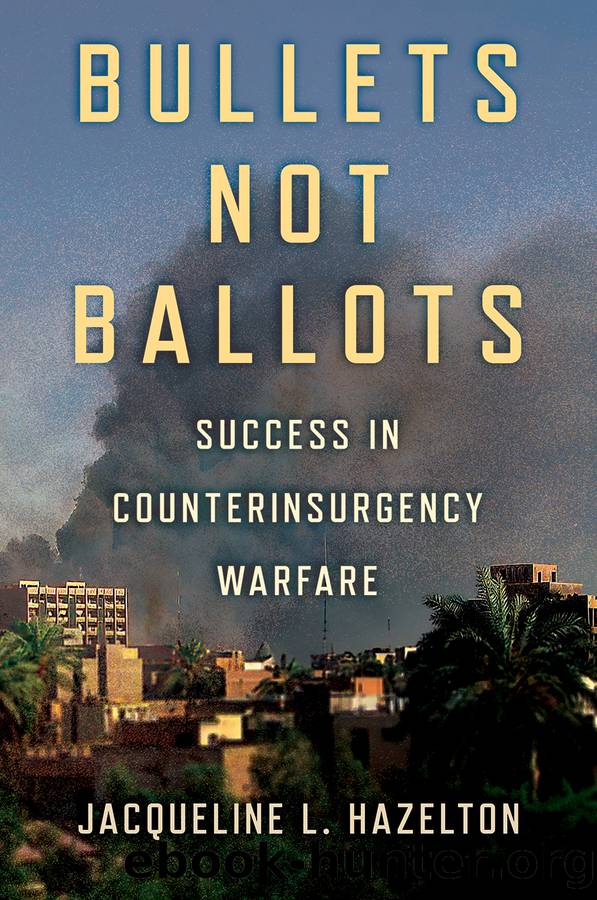Bullets Not Ballots: Success in Counterinsurgency Warfare by Jacqueline L. Hazelton

Author:Jacqueline L. Hazelton [Hazelton, Jacqueline L.]
Language: eng
Format: epub
Tags: political science, Security (National & International), International Relations, General, history, Military, Wars & Conflicts (Other)
ISBN: 9781501754807
Google: xqf-DwAAQBAJ
Publisher: Cornell University Press
Published: 2021-05-15T23:48:58.351822+00:00
El Salvador Analysis
INSURGENCY BROKEN BY 1984
The military defeated the insurgent revolutionary threat to topple the government in 1984, though fighting continued for years after. The date is important in this case because counterinsurgent success is usually identified as taking place with the signing of the peace agreement in 1992, after counterinsurgent gestures toward reforms. Insurgent conventional forces were smashing ESAF units in the field in 1983. But by the end of 1984, U.S.-supplied air power and ground attacks had shattered the insurgentsâ main-force units and destroyed many supportive communities. A mass uprising was highly unlikely by this time. Salvadorans had learned the costs of publicly challenging the government. Indeed, the insurgentsâ so-called Final Offensive in 1981 and another in 1989 failed to spark a popular uprising. By 1984, insurgent military victory was impossible as long as the government retained U.S. backing.
The FMLN started out training campesinos (peasants) in the use of arms with rifles carved out of wood. They conducted raids on military outposts and later on barracks to build their armory.34 In the years from 1979 to 1984, the insurgency developed its army and its rear zones of control and expanded its control to 24â33 percent of national territory.35 By 1983, the FMLN was making large battlefield gains using conventional formations of up to 1,000 fighters in pitched combat.36 There were an estimated 4,000 insurgents in 1980.37 In 1982, the hardcore main force had grown to an estimated 6,000â8,000, rising to 10,000â12,000 in 1983â1984.38
But in 1984, air and ground attacks forced the insurgency to return to small-unit operations. The insurgency could no longer face ESAF on the battlefield, but it expanded its presence to all fourteen departments (provinces) and began a terrorism campaign against state economic targets. The insurgency mounted attacks on military bases and ambushed troops in the countryside to try to grind down Salvadoran and U.S. support for the war.39 In addition, the insurgency emphasized political development, building shadow governments in rural communities, rebuilding its networks in the cities, and offering to participate in peace talks, an offer the United States consistently rejected.40 The FMLN sacrificed some support with its intermittent forced recruitment and its economic terrorism campaign,41 which cut into backing from better-off Salvadorans who opposed extremely abusive state behavior to a greater degree than they supported FMLN tactics.42 Sabotaging electrical lines affected the middle and upper classes, since few poor Salvadorans had electricity or running water.43
In 1985, insurgent strength was at about 9,000â11,000 fighters, reduced from their estimated strength of 10,000â12,000 in 1983â1984.44 By 1989, the military had reduced insurgent ranks to an estimated 8,000 full-time fighters supported by 25 percent of the populace and controlling 15 percent of municipalities.45 In 1990, the insurgency was the local government in 30 percent of El Salvador, had the sympathy of more than half a million Salvadorans, and was fielding 6,000â7,000 full-time fighters and part-time militias of up to 40,000 more.46
In comparison, the ESAF grew from about 10,000 men in 1979 to 40,000 in 1984 and 56,000 in 1987.
Download
This site does not store any files on its server. We only index and link to content provided by other sites. Please contact the content providers to delete copyright contents if any and email us, we'll remove relevant links or contents immediately.
| Automotive | Engineering |
| Transportation |
Machine Learning at Scale with H2O by Gregory Keys | David Whiting(3983)
Never by Ken Follett(3715)
Urban Outlaw by Magnus Walker(3310)
OPNsense Beginner to Professional by Julio Cesar Bueno de Camargo(3230)
Sapiens and Homo Deus by Yuval Noah Harari(2950)
Will by Will Smith(2744)
A Short History of Nearly Everything by Bryson Bill(2585)
Hooked: A Dark, Contemporary Romance (Never After Series) by Emily McIntire(2470)
Rationality by Steven Pinker(2235)
Borders by unknow(2155)
Holy Bible (NIV) by Zondervan(2058)
The Becoming by Nora Roberts(2038)
The One Percenter Encyclopedia by Bill Hayes(1763)
Freedom by Sonny Barger(1747)
HBR's 10 Must Reads 2022 by Harvard Business Review(1744)
A Short History of War by Jeremy Black(1732)
Five Ways to Fall by K.A. Tucker(1668)
Girls Auto Clinic Glove Box Guide by Patrice Banks(1657)
Go Tell the Bees That I Am Gone by Diana Gabaldon(1655)
